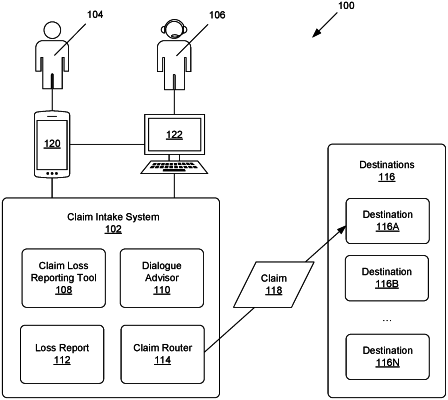| CPC G06Q 40/08 (2013.01) [G06N 5/04 (2013.01); G06N 20/00 (2019.01); G06Q 10/10 (2013.01); G06Q 30/016 (2013.01); G06F 3/0483 (2013.01); G06F 3/0484 (2013.01)] | 20 Claims |

|
1. A computer-implemented method, comprising:
generating, by one or more processors, and based on input provided via a claim loss reporting tool during a communication session associated with an insurance claim, a loss report associated with the insurance claim;
generating, by the one or more processors, and during the communication session, a preliminary destination prediction of a destination, selected from a set of possible destinations, for claim data associated with the insurance claim, wherein:
the preliminary destination prediction is generated, by a dialogue advisor machine learning model associated with the claim loss reporting tool, based on current information in the loss report,
the dialogue advisor machine learning model is an instance of a machine learning model that a claim router, different from the claim loss reporting tool, is configured to use following completion of the communication session to generate a final destination prediction indicating the destination for the claim data, and
the preliminary destination prediction, generated based on the current information, is associated with a first confidence level;
identifying, by the one or more processors, and during the communication session, an empty field in the loss report based on the current information;
determining, by the one or more processors, and during the communication session, a set of possible values for the empty field;
generating, by the one or more processors, during the communication session, and using the dialogue advisor machine learning model, one or more theoretical destination predictions that:
have second confidence levels, and
are based on the current information in the loss report in combination with individual values, of the set of possible values, for the empty field;
determining, by the one or more processors, and during the communication session, that the second confidence levels of the one or more theoretical destination predictions are greater than the first confidence level of the preliminary destination prediction;
determining, by the one or more processors, during the communication session, and based on determining that the second confidence levels are greater than the first confidence level, that filling the empty field with a value would increase a confidence level of the final destination prediction generated by the claim router following the completion of the communication session; and
causing, by the one or more processors, and based on determining that filling the empty field would increase the confidence level of the final destination prediction, a user interface of the claim loss reporting tool to display, during the communication session, at least one user interface element that requests that the empty field be filled,
wherein the machine learning model is trained, based on a training data set associated with assignments of previous insurance claims to destinations based on corresponding loss reports, to identify features that are predictive of the destinations that processed the previous insurance claims.
|